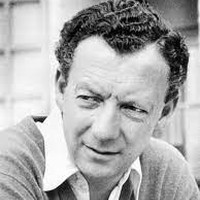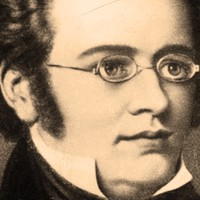Happy Hour Concert: Schubert’s Third Symphony



Benjamin Britten had a precocious start in music, studying piano and viola and composing hundreds of works by the time he was a teenager. At fourteen, Britten’s viola teacher introduced him to the composer Frank Bridge, who agreed to give Britten private lessons. “I, who thought I was already on the verge of immortality, saw my illusions shattered,” Britten later wrote about his course of study with Bridge, a demanding teacher who fostered the rigorous technique needed to round out Britten’s natural inventiveness.
Bridge’s name mostly arises now thanks to the tribute composed by his pupil in 1937. Britten accepted the commission on very short notice from the Boyd Neel Orchestra, which desperately needed a new English piece to play at the prestigious Salzburg Festival. The orchestra had already performed Britten’s Simple Symphony for Strings, making the young composer a natural choice. Britten obliged by writing the Variations on a Theme of Frank Bridge in less than a month.
The source material, taken from Bridge’s Three Idylls for string quartet from 1906, is just the slightest wisp of a melody, which Britten expanded into a set of free variations. Coming out of the dramatic introduction, a chord sustained under a series of plucks reveals itself as the start of the theme. Each brief variation highlights a particular aspect of Bridge’s personality, as outlined by Britten: the Adagio corresponds to “his depth,” the March “his energy,” and the Romance “his charm.” The next three movements drift toward parody, with a Gioachino Rossini-inspired Aria Italiana (“his humor”), a neo-Baroque Bourrée classique with prominent violin solos (“his tradition”), and an irreverent Viennese Waltz (“his enthusiasm”). A fiery Perpetual Motion (“his vitality”) clears the air for the haunting Funeral March (“his sympathy”) and the ethereal Chant (“his reverence”). The work closes with a Fugue and Finale, a testament to Bridge’s “skill and dedication.”
Aaron Grad ©2022

In 1814, at the age of 17, Schubert took a full-time job as a teaching assistant at the school where his father worked. He still attended lessons with Antonio Salieri twice a week, played viola in a student orchestra, and managed to write new music at an astonishing rate. In the next two years, Schubert composed some 300 songs for one or more voices, plus four symphonies, three masses, five musical dramas, three string quartets, three violin sonatas and dozens of other works.
Schubert wrote his Second Symphony during the winter of 1814-15, followed soon after by his Third Symphony, composed between May and July of 1815. For all his efforts to improve his craft, nothing came of Schubert’s symphonic aspirations; neither this symphony nor any other received a public performance before he died at the tragically young age of 31.
As a student composer in Vienna, Schubert could not help but be engulfed by the towering achievements of Haydn, Mozart and Beethoven, who had by then debuted eight of his nine symphonies. Like Beethoven before him, Schubert used the instrumentation and general outline of Haydn’s final London symphonies as a point of entry for his symphonic style. In Schubert’s Third Symphony, the instrumentation, slow introduction and minuet (instead of a Beethovenian scherzo) all point to the influence of the London symphonies.
The Third Symphony begins with a strong, sustained attack on the keynote, spread across several octaves. This was actually a stock opening for a symphony, one that the French called le premier coup d’archet. Mozart went out of his way to include a version in his “Paris” Symphony (“These oxen here make such a to-do about it,” he wrote to his father), and similar gestures begin six out of the 12 London symphonies by Haydn. A sign of Schubert’s originality comes at a point when it seems the introduction could be finished; instead an abrupt key change extends the introduction so a clarinet can engage in song-like dialogue with other woodwinds. The fast body of the movement starts with the clarinet still in a solo role, adding to the sense of cohesion.
By crafting the second movement as an Allegretto instead of a typical Adagio or Andante, Schubert must have had in mind the equivalent movement in Beethoven’s Seventh Symphony, which had debuted in Vienna less than two years earlier. For the third movement Menuetto, Schubert followed the model of Haydn, who brought coarse humor and rustic elements of the Austrian ländler dance to the refined French tradition of the minuet.
With its propulsive rhythms and wild emotional swings, the finale takes Haydn’s hunt-inspired model into a territory that seems distinctly Schubertian. Some details foreshadow a seminal song composed later in 1815, Erlkönig, a supernatural ballad that was published as Schubert’s long overdue Opus 1 in 1821.
Aaron Grad ©2017
Happy Hour: 4–6pm, Concert: 6–7pm
Schubert’s Third Symphony shows us Haydn’s influence on the young composer’s work. Written when Schubert was just eighteen, the symphony remained unpublished until after his death. Variations on a Theme of Frank Bridge is the first work to bring Britten international appreciation, and is a tribute to his former tutor, Frank Bridge.
Beer provided by: Tin Whiskers
Food Trucks: Hot Indian/Alimama's Sambusa/R.A. MacSammy's
Get driving directions and find nearby parking.
Find dining options close to the venue.
View seating charts to find out where you'll be seating.
SPCO concerts are made possible by audience contributions.
For exclusive discounts, behind-the-scenes info, and more:
Sign up for our email club!
